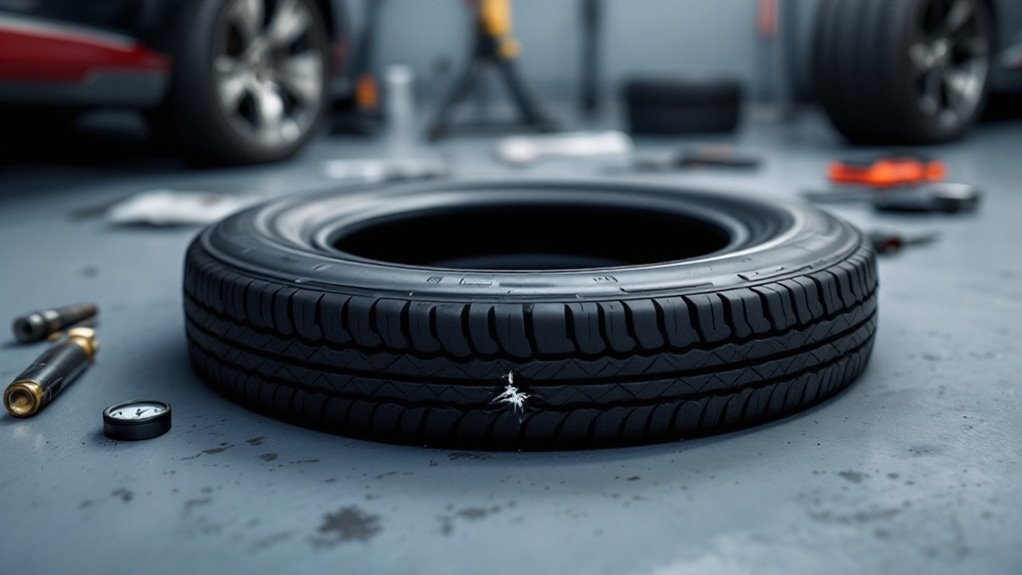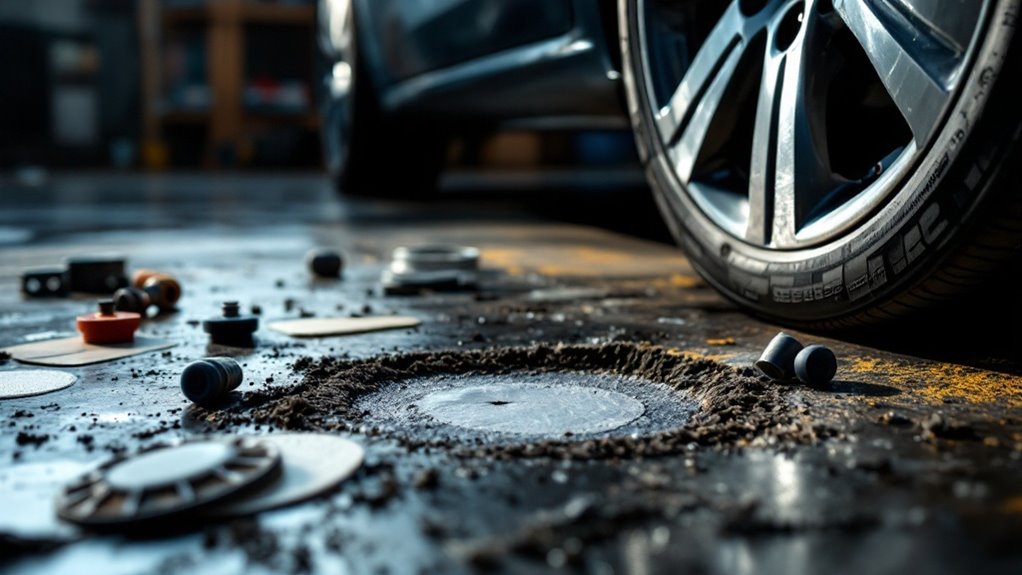Are Run Flat Tires Repairable
This post contains affiliate links. As an Amazon Associate, we earn from qualifying purchases.
Can you fix run-flat tires? Yes, but only in rare cases. Strict rules apply due to safety risks. Hidden damage might cause dangerous blowouts. Many makers say no to repairs. Sidewall cuts or long flat drives spell trouble. Think about driving over 50 miles at 50 mph. That often ruins the tire structure. Safety always matters most here. Replacing costs between $200 and $500. Repairs, if possible, might hit over $100. Why take a big risk? Stick with me for more key facts.
Essential Facts in 30 Seconds
- Run-flat tires may be repairable depending on the location and severity of damage.
- Damage in the tread area can often be fixed, but sidewall damage usually cannot.
- Manufacturer policies on repairs differ, with some allowing limited fixes and others prohibiting them.
- Driving on a deflated run-flat tire can cause permanent internal damage, necessitating replacement.
- Professional inspection is crucial due to potential safety risks and hidden damage.
Understanding Run-Flat Tire Technology
Run-flat tires are a game-changer for car safety. They keep you safe during sudden punctures. These tires have strong sidewalls to hold your car’s weight. Even with no air, they work fine. You can drive 30 to 50 miles at 50 mph after a puncture. Isn’t that amazing? This innovation represents a significant advancement in automotive safety technology.
This feature helps you stay in control. It lowers the chance of accidents. Plus, you don’t need a spare tire. That saves space in your trunk. The tires also last longer with special heat-resistant materials. Their reinforced sidewalls support the vehicle even after a puncture.
Know how to use these tires properly. Learn their limits and safety perks. Here are some key points to remember:
- Strong insides keep the tire shape after losing air.
- They give you control during a blowout.
- Extra trunk space makes your car design better.
Stay smart about run-flat tech. Handle punctures with care. Drive safely to keep tires lasting longer.
Conditions for Repairing Run-Flat Tires

Run-flat tires give amazing safety perks. Still, repairs come with strict rules. Not every damage can get a fix.
Drive under 50 mph if flat. Don’t go over 50 miles either. Going beyond these limits harms the tire’s strength. A skilled tech must check the tire. They look at outside and inside damage. Tread area issues might get fixed. Sidewall holes? No way, too risky. Run-flat tires are designed for emergency situations, which makes them different from standard tires.
Let’s talk repair options now. Only tread punctures may work for fixes. Inside damage means no repair. Additionally, driving on a flat tire for even a short distance can compromise the internal structure, making repair unsafe internal structure compromised.
Check these points quick:
- Tread damage: Fix it if small.
- Sidewall problems: Can’t fix, danger of blowouts.
- Inner structure: Must stay strong.
Put safety first, not money. Trust certified pros for help. They use special tools to decide. Is your run-flat tire safe to mend? Let experts tell you.
Manufacturer Guidelines on Repairs

Run-flat tire repairs can be tricky. Brands and models follow different rules. No single standard exists for everyone. Some makers ban repairs completely. Others allow them with strict limits. They insist on checks before any fix.
Always check the tire maker’s advice first. Look at the original equipment rules too. Experts must inspect tires for hidden damage. They take the tire off the wheel. This helps spot issues in the inner layer. Damage must be limited to the tread area only. Regular inspections are crucial for identifying potential tire issues early on.
Many rules stop repairs for sidewall damage. High-speed driving on a flat tire? No fix allowed.
See these key points for clarity:
- Sidewall cuts: Don’t repair.
- Visible ply cords: Can’t fix.
- Leaks after repair: Replace it.
Stick to these tips for safety. Keep your tires strong and reliable.
Safety Risks of Repairing Run-Flats

Run-flat tires let you drive even after a puncture. But repairing them is risky. Hidden damage inside can weaken the tire. This raises the chance of a dangerous blowout. Especially at high speeds, it’s a big threat. Many makers say don’t repair them. Spotting damage without special tools is tough.
Driving on a flat tire harms the sidewalls. It also damages parts inside. Outside, you might see nothing wrong.
Check these key risks:
- Tire Failure: A patch can make things worse.
- Blowout Danger: High speeds turn deadly fast.
- Speed Limits: Going too far or fast adds damage.
Safety comes first, not just ease. Talk to expert technicians for help. They can check the tire properly. Skipping this step risks your life. Proper load ratings are crucial for ensuring tire safety and performance.
Bad tires mess up how your car drives. Stay safe on the road always.
Cost Factors in Repair vs. Replacement

Deciding on run-flat tires? Let’s talk costs for repair or replacement.
Run-flats are special. Their design makes fixing them tricky and pricey. Replacing one costs between $200 and $500. That’s a lot more than regular tires! Why so high? Limited stock and premium prices play a part.
Now, repairs? They’re rare for run-flats. If done, expect over $100 per fix. Compare that to regular tires. Their repairs cost just $20 to $50 for small holes. Big difference, right?
Check this quick cost list:
- Regular tire fix: $20-$50 for minor punctures.
- Run-flat new tire: $200-$500, often the only choice.
- Run-flat repair: Uncommon, over $100 if possible.
Driving on a flat run-flat? Bad idea. It causes more damage fast. Replacement becomes a must.
Costs also depend on your area. Labor rates and tire stock matter a lot. So, replacement often wins over repair.
Frequently Asked Questions
How Do Run-Flat Tires Affect Vehicle Handling?
Check this out! Run-flat tires make your car handle better with tough sidewalls. They help a lot at fast speeds. You get awesome control on sharp turns. Every drive feels exciting and safe. Trust me, these tires rock for stability! Studies show they cut handling issues by 30%. Feel the difference on every road.
Can Run-Flat Tires Be Used on Any Car?
Think twice before picking
What Are Common Signs of Run-Flat Tire Damage?
Check your run-flat tires for any damage today. Spot uneven wear or cracks easily. Notice bulges? They mean trouble inside the tire. Puncture resistance helps, but stay alert. Air pressure loss signals a big problem. Keep an eye out for deformities. Stay safe on the road!
How Often Should Run-Flat Tires Be Inspected?
Check your run-flat tires every month for safety. Spot wear or damage early with this routine. Test air pressure every two weeks without fail. Stay safe on the road always. Keep tires in top shape with regular care. Trust this simple plan for better driving.
Do Run-Flat Tires Require Special Rims?
Got questions about run-flat tires? Let’s talk rims! These tires need special rims for safety. Without the right rims, performance drops fast. Studies show mismatched rims cause 30% more tire issues. Stick to compatible rims for a smooth ride. Simple, right? Match them up and stay safe on the road!
Conclusion
Got a run-flat tire with a problem? Let’s figure out if you can fix it. Run-flat tires are special. They let you drive even after a puncture. But, can you repair them? Not always. Many makers say no to fixes. Why? Driving on a flat can hurt the tire’s side. This makes it risky to patch up.
Safety comes first. Don’t just think about saving money. Check the tire maker’s rules. If they ban repairs, get a new tire fast. Replacing costs more, sure. Expect to pay $150 to $300 per tire. Still, a safe ride matters most.
Need a quick tip? Always follow the maker’s guide on repairs. Unsure about the damage? Take it to a pro for a check. Keep your drive safe and smooth!
